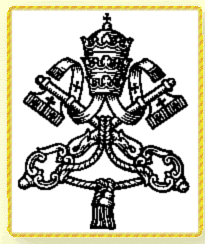VATICAN CITY, MAR 8, 2006 (VIS) - "The Pontifical Swiss Guard, 500 years of history, art and life" is the title of an exhibition due to be inaugurated on March 29 in the Charlemagne Wing at the left colonnade of St. Peter's Square. It will commemorate the five centuries of life of the world's oldest active military force.
The exhibition will present, together for the first time, a series of documents and objects from other museums and institutions reconstructing the history of the corps founded by Julius II. In 1505, that pontiff sent a Bull to the Swiss Confederation communicating the fact that he had entrusted the prelate of the papal court Peter von Hertenstein to recruit 200 Swiss soldiers and lead them to Rome to guard the person of the Pope and the pontifical palaces. The Bull itself forms part of the exhibition, as do the flags that the Holy Father gave to Switzerland in gratitude for the arrival of the soldiers. They, after crossing the Alps, reached Rome on January 22, 1506 and marched to St. Peter's Square where they were solemnly blessed by the Pope.
Other objects of great historical and artistic value include the helmet and breastplate of Emperor Charles V, a sword with the motto of Julius II, and a large number of miniatures representing the most important moments in the life of the Swiss Guard during their service to the Successors of Peter. These depictions include the "Feast on the Capitol for the 'Possesso' of Alexander VII" by Piranesi, "Bernini's machine for the Forty Hours in the Vatican," and "Pius IX in the 'sedia gestatoria'."
One of the most dramatic incidents in the history of the Swiss Guard and of the city of Rome is the famous "Sack of Rome," organized by the troops of Emperor Charles V to "punish" the people of the city and Pope Clement VII. The Pope saved himself by taking refuge in Castel Sant'Angelo, but 147 Swiss Guards perished while defending him. The exhibition recalls this episode with the work "The defense of the Swiss during the Sack of Rome," painted by Giuseppe Rivaroli in 1927. The painting is interesting for its historical "errors," such as the fact that the Swiss Guards are represented wearing their modern uniforms, designed in 1915, and not those in use in 1527.
The numismatic section of the exhibition includes two extraordinary commemorative medals by Benvenuto Cellini: one produced to commemorate the Peace of Cambrai, and the golden medal of Clement VII with "Ecce Homo."
The exhibition also includes a series of portraits, including that of Clement VII by Sebastiano del Piombo, property of the Kunsthistorisches Museum of Vienna, Austria. Also in this section is the triptych kept by the Pope in his private apartments and stolen during the Sack. The work, which is currently kept in the cathedral of Cagliari, Italy, is being returned to Rome for the first time in five centuries.
From the Swiss Guard's own armory and archives, and here displayed for the first time, are portraits of all the commanders of the Guard over the last 500 years, uniforms, and arms and equipment for the parade ground and the field, both ancient and modern. Of particular interest and beauty are the two-handed swords from 1584, used to accompany the pontiff on his "sedia gestatoria" and last adopted during the pontificate of Paul VI.
The exhibition, promoted by Command of the Pontifical Swiss Guard, is being held under the patronage of Bishop Mauro Piacenza, president of the Pontifical Commission for the Cultural Patrimony of the Church, and of various Swiss cultural institutions. It will be open from March 29 to July 30, 2006.
.../SWISS GUARD EXHIBITION/... VIS 060308 (630)
Wednesday, March 08, 2006
Subscribe to:
Post Comments (Atom)










No comments:
Post a Comment